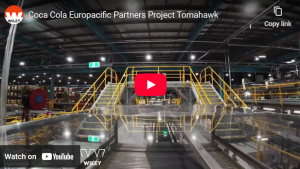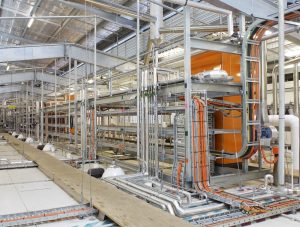
- Industry Type: Industrial Manufacturing, Warehousing, Offices, Refurbishment, Logistics, Food Processing, Distribution
- Author: Andrew Newby
- Service Area: Advice, Design
- Date: 22 Sep 2011
Wiley is proud of the level of insight and expertise we bring to every project we are involved in. A prime factor in our success comes down to these two words and the amazing process they embody.
Master planning is, simply put, the art of comprehensive, long-term strategy. In this article and the tools we have developed, we would like to share with you some of our knowledge on one of the most valuable tools for successfully navigating the minefield of modern manufacturing. Let’s start with why is it so necessary?
Rapidly changing market forces are demanding companies constantly increase and improve their product range. Never before have consumers demanded, or had, so much product choice. Change is inevitable. It is essential for the people in charge to not only understand the impact of change, but to anticipate and plan for it.
This can make you feel like you need a crystal ball to predict these changes and the truth is – you do. But fear not, your ‘crystal ball’, or future mapping device, is master planning. Let’s take a closer look.
“Planning is bringing the future into the present so that you can do something about it now” Alan Lakein
The difficulty of accurate planning lies in the complex pressure exerted by the constant expansion of your facility. All this pressure will affect every aspect of your manufacturing process at one time or another. Your place, people and their purpose will all need to be considered and balanced whilst you are planning the future of your business.
Accepting your raw materials and the space required to store them can be challenge enough. But this increase in stock knocks on throughout your entire facility as each stage requires similar upgrades to process, package, store and finally distribute your finished goods. Consider the process itself – the services required now and in the future, and what treatment techniques to plan for.
Logistics must be addressed to handle the efficient movement of your raw materials from as simple a task as the handling of pallets and crates, to the complex planning of what gets moved where and when. Double handling is the enemy of the efficient.
What about your people? How many more with what skills will you need to cope with increased demand? What is the effect of this increase on the existing facilities?
Think of your master plan as a whole of business tool which requires the input of all business departments to ensure due consideration of all the factors. Involving everyone early in the brainstorming process allows for your company to remain open minded and ‘think big’ during the planning process.
Furthermore, you will discover a variety of potential outcomes and/or issues which, when pieced together, can provide you with a finer understanding of the needs of your people and their place in your overall business. If you find you have arrived quickly at a single option, there is a high probability that you have not truly considered all your options.
It is in identifying, planning for and successfully managing all these pressures that your master plan will continue to prove its value worth time and time again.
The key to developing and implementing any plan is to start somewhere. The primary rule of facility design is flexibility. The more flexible a facility is, the better it can cope with change.
There are a number of ways to build flexibility into your facility:
- Use an open plan by minimising your internal walls and columns. Use wide access corridors to optimise the free flow of traffic and the ability to adapt and change.
- Allow a generous height for your rooms and roof spaces to remove the mouse trap syndrome.
- Accessibility of all your services (water, electricity, heat, waste) and the pipes and ducts they employ is key to the flexibility of your design.
- The flow of your process should be logical and plan for any-way traffic movement – now a reality with the use of Automatic Guided Vehicles.
- Embracing a flexible design for your facility will also create the space required to continue expanding into the future.
Your master plan is a future road map that will enhance the way you react to change, giving your facility the flexibility to adapt and evolve. By predicting future changes and developing proactive plans you will be able to seamlessly incorporate your future plans into your existing process.
All facilities are faced with general and specific unique difficulties when predicting the future. These difficulties can range from the rapid development of your product and process line, to the complex act of consolidating businesses.
A lot of facilities will face substantial challenges to keep ahead of the increasing standards of hygiene. Whilst others may deal with high quantities of uniquely identified components (identified by Stock Keeping Units or SKU's) processed in a batch operation that passes through varying temperatures and conditions during manufacture. Many facilities which process meat, fish or salads may also find flexibility difficult to achieve.
This is where the master plan shines. Whatever combination of challenges your facility currently faces; a well-researched, well communicated and reviewed master plan can not only overcome existing difficulties, but help predict and plan possible ways to avoid having to face the same challenges in the future.
All strategic planning involves costing out potential future developments and calculating the return on investment expected in the profits. It is also true that the exact cost of strategic and master planning cannot, in and of itself, be easily measured. Regardless of these factors, you will certainly notice the mistakes and the costs they demand when you do not employ a strategic master plan for your facility.
Predicting how your food facility must operate in the future can be difficult and the danger is in plowing ahead without taking steps to understand and plot your course forward. Your master plan is your investment in the optimisation of your facility and the successful navigation to a profitable union of your place, your people and their purpose.
The only thing more dangerous than planning is not planning at all.
About the Author
Andrew Newby is the Business Development Director at Wiley and can be contacted on 1300 385 988 or email connect@wiley.com.au.
For a step-by-step guide for your master plan, download your free checklist.
Download to read full article
To read this document you will need Adobe Reader


